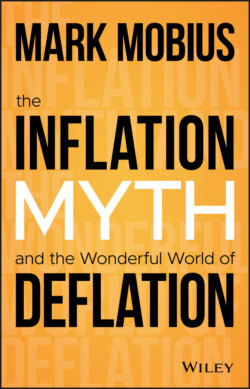Читать книгу The Inflation Myth and the Wonderful World of Deflation - Mark Mobius - Страница 15
Gold and Silver Coins
ОглавлениеFor a while, and during Marco Polo's visit, the system worked. But as the Mongolian Empire expanded, the monetary rules were not always followed through – gold and silver coins ended up being used in some places again. As with previous dynasties, the printing of additional notes to fund military activity was a harbinger of the end of the regime. The Yuan Dynasty's successor, the Ming Dynasty, began its reign in 1368 and would rule China for the next 277 years until the mid‐seventeenth century. To begin with, the new regime under Emperor Chu Yuan‐chang returned the money supply to coinage: in 1361, prior to his rise to Emperor, he ordered the making of a new mint of copper coins. Coins then became the sole currency until 1375, when lack of sufficient copper supplies saw a return to paper currency. However, the circulation of coins continued until the end of the century, and it was only via the third Ming emperor, Yung‐lo, that coins were successfully removed from circulation – a decision, perhaps unsurprisingly given previous Chinese rulers, that was the result of the need to fund military campaigns.
Both under Chu Yuan‐chang and Yung‐lo, the use of paper currency was marked by a sustained rise in prices. As described in Hyperinflation: A World History by He Liping, rice prices rose 6.6% annually for this 50‐year period and under Yung‐lo's rule, when paper currency was in sole use, it rose 11% annually. As well as rice, there were also large rises in the price of gold, silver, copper, and grain. The result was that by 1435, the paper currency was dropped altogether. Copper coins were minted again, as they would be for the remainder of the Ming Dynasty: silver, too, grew in circulation, with the government allowing people to pay their land tax in silver. Trade with the rest of the world also grew and this, too, was paid in silver.
Not only did the Ming Dynasty not return to paper currency, its successor – the Qing Dynasty – also eschewed the paper system for almost all of its 200‐plus years rule. The two exceptions to this were between 1651 and 1661, and between 1853 and 1861, both to fund military activity. In the latter case, Emperor Hsien‐Feng attempted to overcome previous problems by setting up a system of Coin Houses. The idea was that people with paper currency could exchange them for silver notes, which in turn could be exchanged for silver or copper coins. This convertibility, in theory, should have set the value of the notes and enforced people's faith in them. In practice, the Coin Houses didn't offer the full value of coins or silver notes but demanded substantial discounts in order to exchange them.
Today, the Ming banknote is a historical artifact, with an example on display at the British Museum, which was featured in the BBC series A History of the World in 100 Objects. The British Museum note is worth 1,000 coins, with the design showing a drawing of the number of coins it represents. In practical terms, it was clearly a great step forward: this one note was the equivalent of 3 kilograms or 1.5 meters of copper coins (Chinese coins at the time had a hole in the center so they could be collected onto a piece of string – a long piece of string in this case!). That was the theory, anyway. Fifteen years after the launch of the paper currency, this 1,000‐cash note was worth just 250 coins. And while a note from the time of the currency claimed, “Whenever paper money is presented, copper coins will be paid out, and whenever paper money is issued, copper coins will be paid in,” the governmental urge to print more money rendered it unworkable. While the note bears the legend “to circulate forever” it is today instead a historic reminder of another system that went wrong.
